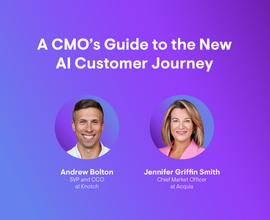How to Increase Brand Mentions and Citations in AI Search
As AI-powered search engines become the primary way users find information, simply showing up in search is no longer enough. The new path to success isn't just about achieving basic visibility; it's about actively influencing how AI models view, interpret, and ultimately recommend your brand in their generated answers.
This requires a deliberate shift in your strategy, moving beyond traditional SEO tactics to a more sophisticated approach focused on structuring data and building trust with an AI.
How do I get my brand to show up in AI search?
Ensuring that your brand is visible in AI search is a critical aspect of driving success in the new new digital era. Throughout the industry, the process of optimizing your AI search visibility is called AEO / GEO.
To influence how AI search recommends your brand, you first need to understand how AI "thinks." Unlike traditional search, which heavily relies on matching keywords to documents, AI search operates on a much deeper level. Its goal is to understand the context of a query and provide a direct answer by pulling together information from countless sources.
Creating well-structured, authoritative, and digestible content is key for driving brand visibility in the AI age. The AI models draw from a wide variety of data, including their training data from web crawls, licensed datasets, and even live information retrieved from the web to answer a query. How clear and reliable your brand's information is across these sources directly influences how you are represented.
Getting your brand to show up in AI search is really going to come down to whether or not you have a technology that can give you visibility into where you're mentioned and where you're cited by AI.
Structure your data to enhance AI visibility
The most direct way to communicate with an AI search engine is through structured dataStructured Data
Structured data is the term used to describe schema markup on websites. With the help of this code, search engines can understand the content of URLs more easily, resulting in enhanced results in the search engine results page known as rich results. Typical examples of this are ratings, events and much more. The Conductor glossary below contains everything you need to know about structured data.
Learn more. This involves using a standardized format, like Schema markup, to explicitly label your content, telling the AI exactly what your information is and how it relates to other entities. By structuring your data, you make your brand's information machine-readable and making it easy for AI to process, verify, and feature in its responses.
Leverage Schema markup for brand visibility
Schema markup provides a vocabulary that AI models understand. Implementing it on your website is like creating a detailed, official file on your brand for the AI to reference. Start with the foundational Schema types that clearly define who you are and what you offer:
- Organization Schema: This is your brand's digital identity card. This helps the AI confidently identify and differentiate your brand.
- Product Schema: For every product you sell, use this markup to detail its name, description, brand, SKU, price, availability, and aggregate rating. This structured information helps AI pull it into product comparisons and recommendation carousels.
- Service Schema: Similar to Product Schema, this defines the services you offer. Detail the service, the area (geographic location), the provider (your organization), and what the service includes.
- FAQPage Schema: Mark up frequently asked questions on your pages. This provides the AI with ready-made, concise answers to common user queries about your brand or products, making your content a prime source for direct inclusion in AI answers.
- Review Schema: Use this to mark up genuine customer reviews, including the author and review. This feeds directly into the AI's understanding of your brand's reputation and trustworthiness.
Optimize your on-page content
Beyond schema, the structure of your on-page content matters, too. AI models favor content that is well-organized and easy to parse.
- Use clear headings: Employ a logical hierarchy of headings (H1, H2, H3) to structure your content. This helps the AI understand the main topics and subtopics of a page.
- Leverage lists and tables: Bulleted lists, numbered lists, and data tables are easily digestible formats for an AI. They allow the model to quickly extract key features, steps, or data points for inclusion in its summaries.
- Be clear and brief: Use clear, factual, and concise language. Avoid jargon where possible. Short paragraphs that directly answer a question or address a user's need are ideal for AI summarization.
Maximize your brand authority and expertise
AI models, much like humans, look for signals of expertise, authoritativeness, and trustworthiness (a concept similar to Google's E-E-A-T ). An AI is more likely to cite or recommend a brand it perceives as a credible authority. This trust is built through consistent signals across the web. Consistent citations of your brand, mentions on authoritative third-party news sites and industry blogs, and positive reviews all contribute to this perception. Furthermore, ensure your own website clearly states who is responsible for the content, with clear author biographies (Person schema) and organizational information.
Optimize content quality and format for AI
Review your existing content to ensure it's "AI-friendly." The content that is most likely to be summarized by AI is factual, well-structured, and directly addresses a user's need.
Create content that answers the "who, what, why, and how" for common questions in your industry. If your content provides the best, most direct answer, the AI has a strong incentive to use it as a primary source for its generated responses.
Measuring and maximizing your AI visibility
Influencing AI is not a "set it and forget it" task. You’ll need to continually monitor how your brand is appearing in AI search. You can perform manual checks to ask common questions related to your brand and industry on various AI search platforms.
Track your brand mentions, the context your brand appears in, the sentiment of the response, and whether you are receiving citations. Use this feedback loop to identify gaps in your content and data structure. If an AI provides an incorrect answer about your brand, it's a clear signal that you need to create and structure content that provides the correct information more clearly.
Optimizing for AI search is different than optimizing for traditional search engines.
Some aspects are similar; it's still about optimizing content gaps and then filling those gaps, but you just have to do it at scale. You're going to have to move a lot quicker. You can't do this manually.
Platforms like Conductor can also track your AI visibility at scale with our AI Search Performance and AI Topic Map features, which surface insights into how your site is performing in AI search and where you have opportunities to improve.
Moving beyond basic visibility measurement to maximizing AI search visibility is the next stage of digital marketing. It requires a complete shift towards creating unambiguous, authoritative, and machine-readable content about your brand. By structuring your data with schema markup and optimizing your content for clarity and authority, you can move from being a passive subject of AI search to an active participant in the conversation.

![Patrick Reinhart, VP, Services and Thought Leadership, [object Object]](https://cdn.sanity.io/images/tkl0o0xu/production/9bc72298b24ad01b732de4c3376f79546d20f81c-3542x3542.png?fit=min&w=100&h=100&dpr=1&q=95)






